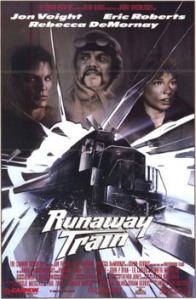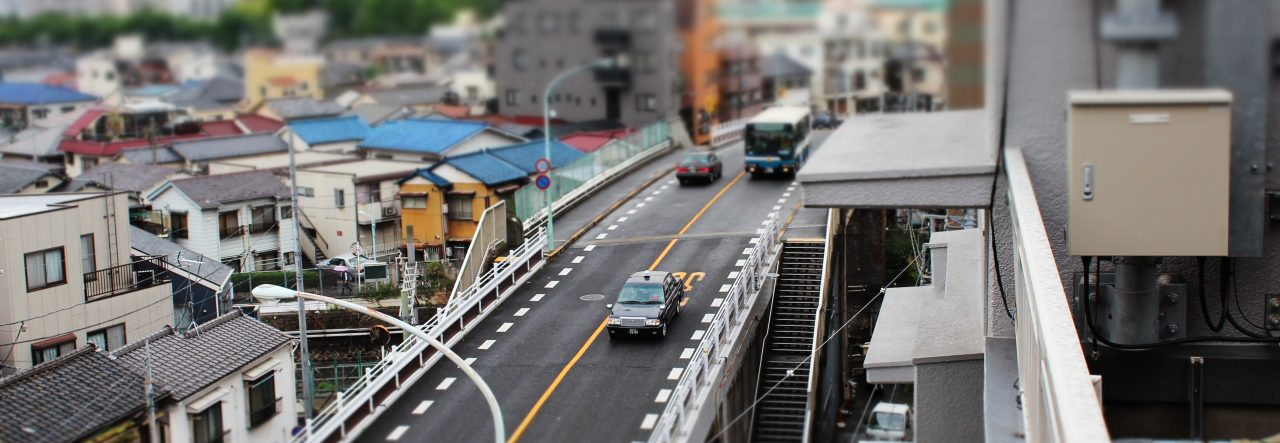Two felons break out of an Alaskan maximum security prison in the middle of winter.  When they find come across a train leaving a depot it seems like their ticket to freedom and escape from the snow and the cold – but a freak accident traps them aboard as the unmanned train picks up speed, out of control and unable to be stopped. This is Runaway Train (1985). Starring Jon Voight (Midnight Cowboy, Heat) and Eric Roberts (The Pope of Greenwich Village, The Dark Knight) as the escapees and directed by Russian director Andrei Konchalovsky, Runaway Train is an unexpectedly brilliant thriller – but why is it on Kino 893?
When they find come across a train leaving a depot it seems like their ticket to freedom and escape from the snow and the cold – but a freak accident traps them aboard as the unmanned train picks up speed, out of control and unable to be stopped. This is Runaway Train (1985). Starring Jon Voight (Midnight Cowboy, Heat) and Eric Roberts (The Pope of Greenwich Village, The Dark Knight) as the escapees and directed by Russian director Andrei Konchalovsky, Runaway Train is an unexpectedly brilliant thriller – but why is it on Kino 893?
Because it was based on an undeveloped screenplay than none other than Akira Kurosawa.
According to Stuart Galbraith IV’s exhaustive Kurosawa/Mifune biography The Emperor and the Wolf (incidentally, a must-read reference for any Kurosoawa fan), Runaway Train was effectively born out of Kurosawa’s ambition to direct outside of Japan following Red Beard in 1965. He was helped by Joseph E. Levine, who was involved in the original transition and marketing of Godzilla (1954) into the Americanised Godzilla, King of the Monsters! (1956). The plot was inspired by a genuine incident of a runaway train in upstate New York that Kurosawa read about in a translation of a Life magazine article, which can now be found online.

The original, Japanese script was written by Kurosawa and frequent collaborators Hideo Oguni and Ryuzo Kikushima, and translated into English by Sydney Carroll. A probable version of this (the translator is uncredited) still exists, and apparently bears strong similarities to the script Konchalovsky would eventually shoot. There are striking differences too, though, with Runaway Train as-filmed featuring a much longer introduction to the prisoners, Manny and Buck, while still in prison, long before the train ever enters the picture. The third passenger is also different: in the original screenplay, ‘Charlie’ is an inexperienced male sheet metal worker; in the actual film, Sara (Rebecca de Mornay) is a young woman, which adds an extra layer of tension between her and the prisoners. Perhaps most significantly there are big changes to the end of the film that all stem from the introduction of an actual antagonist in the form of the prison’s sadistic Warden Ranken (John P. Ryan), while in the original script, it’s more about the occupants of the train versus the train itself.
Had Kurosawa ever filmed Runaway Train as planned, it would have been in the late 1960s, perhaps ‘67 or ‘68. Delays due to discussions over the script, or perhaps the budget, and Kurosawa’s indecision over whether to film in summer or winter eventually led to the project’s cancellation. A significant factor seems to have been an offer from 20th Century Fox for Kurosawa to participate in Tora! Tora! Tora!, but he would eventually drop out of that film as well – the Japanese segments of the joint Japanese-American production would ultimately be filmed by Kinji Fukasaku and Toshio Masuda. It’s a real shame that we never got to see Kurosawa’s version as intended, but I strongly disagree with Galbraith over the quality of Andrei Konchalovsky’s film. If nothing else, I left the movie feeling – before I had read anything further about the project – that its origins as a Kurosawa script were obvious, whereas Galbraith thinks “there is little to suggest its roots” in his works. He slams the acting of Voight and Roberts (both of them received Oscar nominations for their roles) and dislikes the very worthwhile introductory sequence in the prison, but I would agree that the Warden’s actions towards the end of the film stretch belief.
Following the failure of both Runaway Train and his exit from Tora! Tora! Tora!, Kurosawa would never again be as prolific in his native Japan as in those earlier years leading up to Red Beard. He would only make two films, Dodes’ka-den (1970) and Dersu Uzala (1975) before George Lucas and Francis Ford Coppola, horrified to find the acclaimed director struggling to get funding for his projects, financed Kagemusha in 1980.

So with Kurosawa’s involvement in the genesis of the project set aside, what remains of Runaway Train? During the lengthy prison introduction, we get to meet Manny, a felon apparently so violent he’s been literally welded into his cell for three years. As the film opens, he’s just won a civil rights appeal and is about to be let back out into gen pop. This news has the prison on edge – his fellow prisoners seem to idolise him, or maybe they just empathise with him as a symbol of opposition to the warden. It’s never quite made explicit just what kind of man Manny is: does he really deserve to be kept in solitary, or is he a victim of the warden, who sees him only as a hopeless recidivist with no human rights? Certainly, Manny doesn’t help his case when he almost immediately makes another escape attempt – nor do his actions aboard the train, taking advantage of the more naive Buck, paint him in a sympathetic light. Yet, he’s more than that, and Voight’s angry portrayal of him is a man who seems to wish he could fit into society, resents the fact that he doesn’t, and yet is incapable of changing. It’s hard to imagine now, but Voight at the time was an ‘All-American good guy’, and playing Manny was massively against type. In an interview discussing the film, Konchalovsky recalls having to persuade Voight to actually take the role, to see it as a personal test.

Buck is a much less complex character – a naive, abrasive loudmouth who represents all the other prisoners’ idolisation of Manny. He’s no actual friend of Manny, nor is he much more than a tool in Manny’s escape plan, but he insists on tagging along anyway. When pushed, he tries to be heroic – but this seems driven more out of a need to impress Manny than a desire to actually self-sacrifice, and Manny is all too ready to exploit that. Sara is the least developed of the three protagonists, serving primarily as a means to explain to the two prisoners how the train works and propose a possible method of slowing it down by gradually decoupling the engines one by one. Of course, the train itself should not be overlooked as a character in its own right; the scene where it emerges through a fog of steam in the train yard is one of the film’s best.

Whether or not you’re interested in the Kurosawa connection, Runaway Train is well-worth tracking down as a relatively obscure and quite forgotten gem from the mid-1980s. The whole thing is riveting and it has a fascinating backstory to boot.
Runaway Train / 暴走機関車
Director: Andrei Konchalovsky
Release Date: 6th December 1985 / Japanese Release Date: 7th June 1986
Version Watched: 111 min (Arrow Video)
